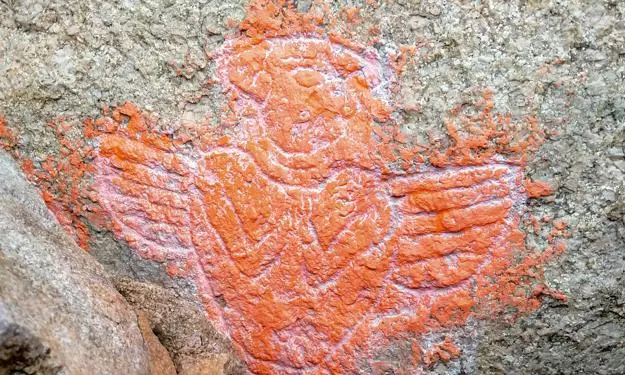
Telangana | Post-Kakatiya era petroglyphs found in Anantagiri
The petroglyphs belong to the later part of 14th century and had been the work of Recharla Padmanayakas, who ruled Telangana from Rachakonda after the Kakatiyas

In a significant discovery, post-Kakatiya petroglyphs were found in the caves of Anantagiri located in the precincts of Ramnunthala, Amangal Mandal, Ranga Reddy district.
There is a heap of stones situated in a furlong distance from Srisailam-Hyderabad highway, forming several caves. As per a release issued by noted historian Dr D Satyanarayana, who is also the Curator of Tribal Museums, Govt of Telangana, the main east facing rock shelter that looks like snake hood contained numerous prehistoric paintings, and medieval petroglyphs.
As per a release issued by noted historian Dr D Satyanarayana, who is also the Curator of Tribal Museums, Govt of Telangana, the main east facing rock shelter that looks like snake hood contained numerous prehistoric paintings, and medieval petroglyphs.
But, in recent times, the local Lambadi tribals started worshipping the petroglyphs by whitewashing the prehistoric ochre colour paintings and applied ochre colour (jaaju) on the petroglyphs.
3 petroglyphs on surface
“As a result, at present, only three petroglyphs appear on the surface of the main cave. The first space which is one foot long and half foot high contains two figures – a horse and Lord Ganesha in ‘ardha sukhasana’ pose. The Ganesha looks like a mother goddess also stretching hands up and legs down; this is the reason that some local people call it Goddess Bhadrakali, the consort of the adjacent God Veerabhadra staying in the nearby Ayyasagar caves,” he said.
The second space, which is one and a half feet long and half feet wide, contains the petroglyph of a hooded snake in an erect pose. A boulder situated in the south-east side of the main rock shelter contains two petroglyphs of two feet long each. One of them is of Lord Hanuman and the other one is of Garuda/Garutmantha (celestial eagle). Each of them is depicted to be standing with folded hands facing the main rock shelter.
There is a cavern in the south-western corner of the main rock shelter. In fact the main adorable figure of a deity or Guru is depicted in this cavern. The 3 feet long and two feet wide male figure is in ‘padma asana’ pose (sitting in legs criss-crossed) and the Guru has long hairs that he coiled them in 4 layers one over another on his head. There are two holes on either side of the figure conveying that our ancestors inserted sticks in the holes to place garlands around the neck of the Guru figure.
14th century petroglyphs
According to Dr Satyanarayana, the petroglyphs belong to the later part of 14th century and had been the work of Recharla Padmanayakas who ruled Telangana from Rachakonda after the celebrated Kakatiyas.
When the Padmanayakas waged over Kanchi during the latter part of 14th century Singabhupala-II invited the famous Vaishnava teacher Vedanta Desika to his kingdom. But the latter sent his son Nainacharya. Thereafter the Padmanayakas started constructing and worshipping Vaishna temples of Lord Rama, Narasimha, Gopala Krishna, Vishnu, etc in addition to Guru Vedanta Desika/Nainacharya.
In the precincts of the temples, sacred caves and forts constructed by Padmanayakas, we can see the figures or sculptures of Lord Hanuman, Garuda (celestial eagle), Ganesha, Shivalinga and serpent. The petroglyphs of the same are found in the said caves. In fact this tradition itself was initiated by the Padmanayakas in this area itself because they called themselves "Anumanaganti Puravaraadheesvara” (Lords of Amangal); in other words, Padmanayakas hailed from Amangal which is just 4 km away from the present site.
Important to protect
"Thus, since the petroglyphs in question are the rare petroglyphs of 14th century history of Telangana they should be protected by the Department of Heritage, Telangana, before they are vandalised," he added.

